I'm seeking to get a better understanding of what the early forms of plate augmentation for the arms and legs that developed in Europe in the late 13th century looked like. What are some good manuscript illustrations or surviving peices to get a sense of what of early "partial plate" armour looked like?
Plate leg defenses appear earlier. One of the earliest references for enclosed greaves appears in the 1302 Inventory of Raoul de Nesle, the Constable of France killed at the Battle of Courtrai.
Item ii harnas de gaumbes fourbis de coi les greves sont closes cs.
Item, 2 leg harness polished with enclosed greaves. 100 s
Item unes autres demie greves fourbies iiiil.
Item, one other half-greaves, polished. 4 l.
Unfortunately the words used to describe these defenses (schynbalds, jambiers, trumelières, etc.) don't explain their appearance.
 Attachment: 16.46 KB
Attachment: 16.46 KB
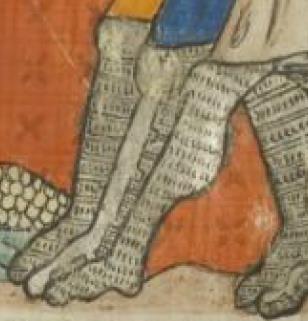
Apocalypse, Toulouse BM MS.815 fo.27v, 1220-1270
 Attachment: 158.33 KB
Attachment: 158.33 KB
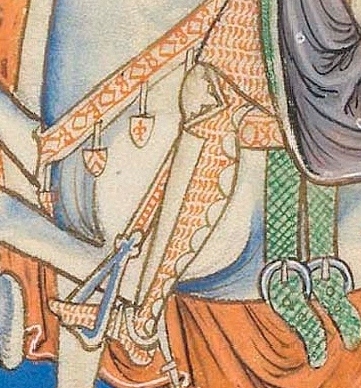
Trinity Apocalypse, Cambridge MS R.16.2 fo.23r, c.1250
 Attachment: 48.96 KB
Attachment: 48.96 KB
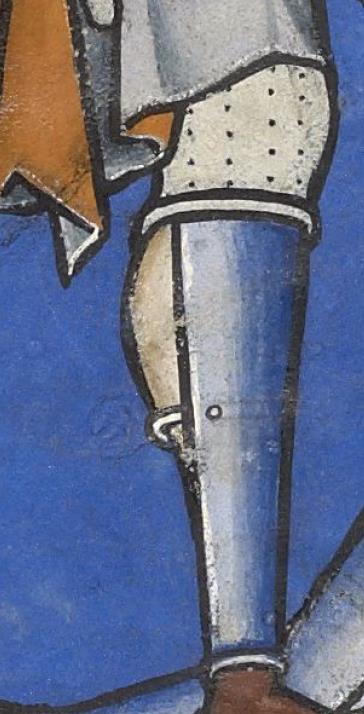
'Goliath', Maciejowski Bible, Morgan M.638 fo.28v, 1240-1250
 Attachment: 55.73 KB
Attachment: 55.73 KB
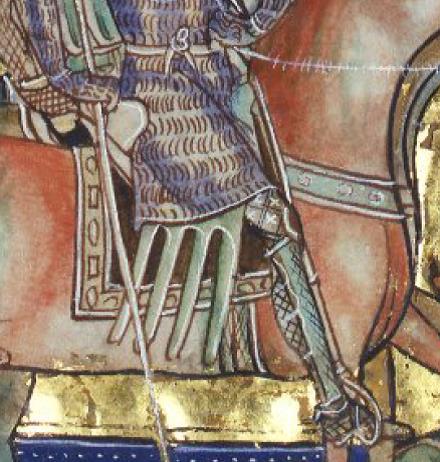
Lambeth Apocalyspe, LPL MS 209 fo.11v, late 13th century.
 Attachment: 78.21 KB
Attachment: 78.21 KB
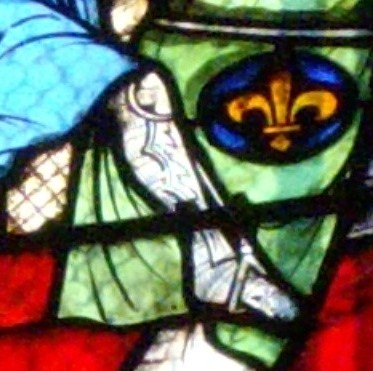
Cathédrale Notre-Dame de Paris, 1214-1270
Item ii harnas de gaumbes fourbis de coi les greves sont closes cs.
Item, 2 leg harness polished with enclosed greaves. 100 s
Item unes autres demie greves fourbies iiiil.
Item, one other half-greaves, polished. 4 l.
Unfortunately the words used to describe these defenses (schynbalds, jambiers, trumelières, etc.) don't explain their appearance.

Apocalypse, Toulouse BM MS.815 fo.27v, 1220-1270

Trinity Apocalypse, Cambridge MS R.16.2 fo.23r, c.1250

'Goliath', Maciejowski Bible, Morgan M.638 fo.28v, 1240-1250

Lambeth Apocalyspe, LPL MS 209 fo.11v, late 13th century.

Cathédrale Notre-Dame de Paris, 1214-1270
A rare example of some possible forearm and shoulder plates.
http://manuscriptminiatures.com/4345/18978/
[ Linked Image ]
Effigy formerly attributed to Sir William Longespée the Younger, (+1250 Battle of Mansourah), Salisbury Cathedral. Sometimes dated 1250-1270, now listed as an "Unknown 14th century warrior" due to "recent research".
[ Linked Image ]
Simple roundels or cups over the elbow are usually the most plate on the upper limbs found in thirteenth century art.
Supplemental leather defenses over the mail should also be considered.
http://armourinart.com/169/261/
[ Linked Image ]
http://manuscriptminiatures.com/4345/18978/
[ Linked Image ]
Effigy formerly attributed to Sir William Longespée the Younger, (+1250 Battle of Mansourah), Salisbury Cathedral. Sometimes dated 1250-1270, now listed as an "Unknown 14th century warrior" due to "recent research".
[ Linked Image ]
Simple roundels or cups over the elbow are usually the most plate on the upper limbs found in thirteenth century art.
Supplemental leather defenses over the mail should also be considered.
http://armourinart.com/169/261/
[ Linked Image ]
| Mart Shearer wrote: |
| Plate leg defenses appear earlier. One of the earliest references for enclosed greaves appears in the 1302 Inventory of Raoul de Nesle, the Constable of France killed at the Battle of Courtrai.
Item ii harnas de gaumbes fourbis de coi les greves sont closes cs. Item, 2 leg harness polished with enclosed greaves. 100 s Item unes autres demie greves fourbies iiiil. Item, one other half-greaves, polished. 4 l. Unfortunately the words used to describe these defenses (schynbalds, jambiers, trumelières, etc.) don't explain their appearance. |
Plate-lined surcoats were also appearing mid-13th century.
Matthew
Matthew
| Mart Shearer wrote: |
| Plate leg defenses appear earlier. One of the earliest references for enclosed greaves appears in the 1302 Inventory of Raoul de Nesle, the Constable of France killed at the Battle of Courtrai.
Item ii harnas de gaumbes fourbis de coi les greves sont closes cs. Item, 2 leg harness polished with enclosed greaves. 100 s Item unes autres demie greves fourbies iiiil. Item, one other half-greaves, polished. 4 l. Unfortunately the words used to describe these defenses (schynbalds, jambiers, trumelières, etc.) don't explain their appearance. |
So ...
With "two leg harness the inventary is meaning a contemporary whole set that includes a pair of closed greaves or the leg harness is solely the closed greaves? By 1302 things like padded cuisses and knee-caps were to universal, right? I'm intrigued by the fact that, apparently artistic evidence seems to induce you that all the plate innovations (i.e. Armoured Surcoats; Greaves; elbow, shoulder and knee plates) wouldn't be common and popular until the 1330's, more or less. Can we trust in artistic evidence for that? I don't know any website with armour's inventories, so I'm also quite limited on that.
------
About written evidence for Coat-of-Plates: According to Ian Heath in Armies of Feudal Europe (1066-1300), the first accepted evidence for the CoP comes from a Florentine war-order of 1250-60's, describing a new equipment of the German knights which were serving as mercenaries. Italian sources also seen to indicate that it was the german who brought such equipment to the peninsula: the battle of Benevento mentions the German mercenaries were well protected by such innovations; E. Oakeshott also describes the battle in his book (https://en.wikipedia.org/wiki/Battle_of_Benevento). Besides this, we have Magdeburg Cathedral's Saint Maurice icon, dated 1250, and a pair (I guess) of another iconography of the sleeping soldiers at Christ's tomb, from Germany but of latter decades. Scandinavian sources like the Speculum Regale (dated 1250) mentions that all the knights were obligged to have one (the squires weren't, however), so apparently such equipment was quite popular in Germany and neighbours (probably all those CoP made in Germany itself) but artistic evidence isn't conformed with that.
If you wanna read more, I edited this article: https://en.wikipedia.org/wiki/Coat_of_plates
Page 1 of 1
You cannot post new topics in this forumYou cannot reply to topics in this forum
You cannot edit your posts in this forum
You cannot delete your posts in this forum
You cannot vote in polls in this forum
You cannot attach files in this forum
You can download files in this forum
All contents © Copyright 2003-2006 myArmoury.com — All rights reserved
Discussion forums powered by phpBB © The phpBB Group
Switch to the Full-featured Version of the forum
Discussion forums powered by phpBB © The phpBB Group
Switch to the Full-featured Version of the forum